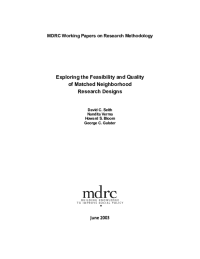Exploring the Feasibility and Quality of Matched Neighborhood Research Designs
Many evaluations of neighborhood-level interventions have relied on neighborhood matching strategies, but to the authors’ knowledge the validity of this methodology has not been tested. This paper responds to the demand for rigorous evidence on the use of quasi-experimental neighborhood matches for assessing the effectiveness of community-wide interventions. Using neighborhood-level data in Cleveland, Ohio, and Philadelphia, Pennsylvania, to match potential target neighborhoods to virtual comparison neighborhoods, this paper evaluates the number of target neighborhoods that can be matched and how well they stay matched over time. It identifies a range of matching variables and constraints that appear to strike the best balance between matchability and match quality. The results compare favorably to those generated by two less restrictive alternatives. The paper ends with suggestions for replication in other sites, with other outcomes, and in other time periods. It tentatively concludes that the neighborhood-matching algorithm described in this analysis is both operationally feasible and offers respectable accuracy in detecting the magnitude of impacts that might be expected from neighborhood-based employment interventions.







